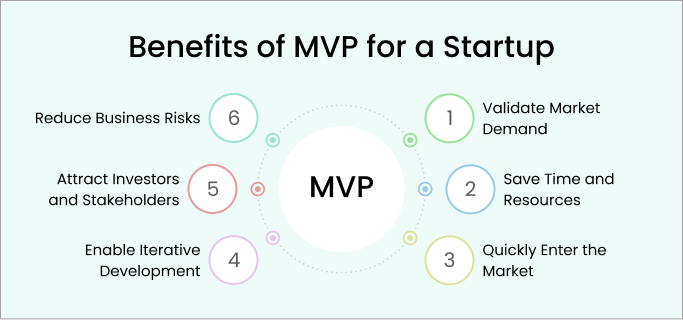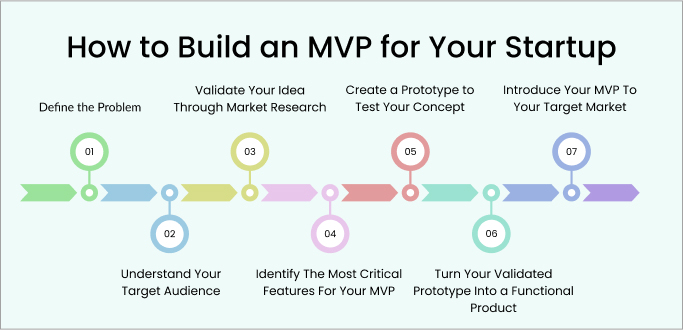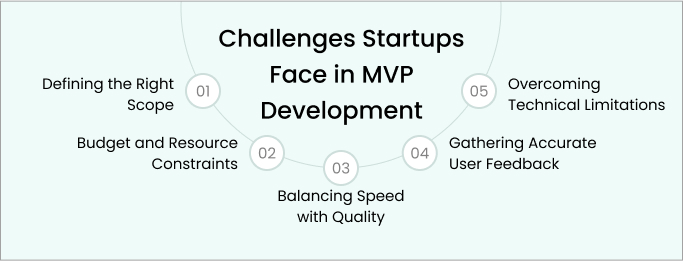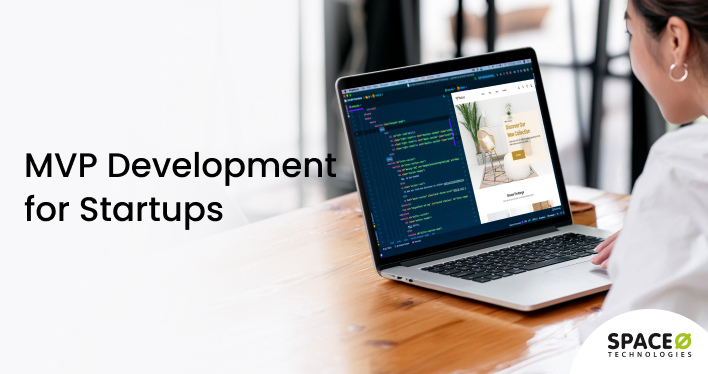Table of Contents
Starting a new business is an exciting yet challenging journey, and one of the biggest questions you’ll face is: How do I turn my idea into a product that customers actually want?
Instead of building a fully polished product from the get-go, MVP development allows you to create a simplified version of your web app, mobile app, or software that zeroes in on the most critical features. It’s a smart, cost-effective approach to validate your idea, gather real user feedback, and make adjustments before scaling up.
In this blog, we’ll explore why MVP development for startups is a game-changer, how to approach it the right way, and how partnering with an MVP development company like Space-O Technologies can help you build a product that not only meets customer needs but also sets your business up for long-term success. Let’s read further.
What is an MVP?
A Minimum Viable Product (MVP) is the most basic version of a product that addresses a specific problem for its target audience. It includes only the essential features needed to deliver value to early users, allowing you to collect feedback and validate your concept before fully developing the product.
The MVP approach is particularly beneficial for startups because it enables you to test your assumptions, understand your audience’s true needs, and make data-driven improvements—all without committing substantial time or resources upfront. This method helps mitigate risk while ensuring that the product you’re building is aligned with market demand.
Though MVP development process for a web app might focus on core functionalities such as account creation or content sharing while deferring more complex features like analytics or user profiles to future iterations.
Whereas mobile app MVP may prioritize intuitive navigation and essential interactions, such as booking or tracking, to quickly gauge user interest. MVP software development delivers the fundamental tools needed to solve a critical business challenge, without the inclusion of advanced features or integrations.
Why Do Startups Need an MVP?

Startups operate in dynamic, high-pressure environments where every decision counts. Resources are often limited, timelines are tight, and there’s little room for error. Partnering with specialized MVP development companies offers startup businesses a practical, efficient approach to overcoming these challenges through MVP development. Here’s why MVPs are crucial for startups:
Validate market demand
Building a product without knowing if there’s demand can lead to wasted effort and resources. Startups often have innovative ideas, but assumptions about user needs might not align with reality.
An MVP helps validate whether a market exists for the product by putting the idea in front of potential customers. Through surveys, analytics, and user interactions, startups can determine:- Are people willing to pay for the solution?
- Does the solution address their pain points effectively?
- What are the most valued features?
Example:
Dropbox started with a simple explainer video as its MVP to gauge interest, which led to thousands of sign-ups before they built the product.
Save time and resources
Developing a feature-rich web, app, or software product from scratch can be costly, particularly for startups working with tight budgets and limited manpower. Space-O Technologies builds lean MVPs focused on core functionality, reducing the investment required to get a product into users’ hands.
- Startups can avoid overinvesting in unnecessary features.
- It allows teams to work leaner, focusing only on what’s necessary to demonstrate the product’s value.
- Resources saved during this phase can be redirected to refining and scaling the product later.
By launching early and iterating based on feedback, startups optimize the use of their resources. According to CB Insights, 38% of startups fail due to running out of cash. An MVP can help mitigate this risk by reducing initial development costs.
Quickly enter the market
Speed is essential for startups, as competition often comes from well-funded incumbents or other startups pursuing similar ideas. Launching an MVP for tech startups allows to:
- Stake a claim in the market by addressing user needs quickly.
- Attract early adopters, who often become brand advocates.
- Establish a feedback loop before competitors even launch.
Example:
Twitter initially launched as a simple platform for sending 140-character updates. This MVP was enough to capture attention and grow into a global phenomenon.
Enable iterative development
An MVP promotes a feedback-driven approach to product development. Startups release a basic product and then refine it based on their input. This iterative process ensures continuous improvement while remaining user-focused.
- Developers gain insights into which features users love and what can be discarded.
- Iteration minimizes guesswork, as data drives decisions rather than assumptions.
- Startups can adapt to market changes, ensuring their product stays relevant.
Example:
Instagram started as a check-in app before pivoting to focus solely on photo sharing based on user feedback.
Attract investors and stakeholders
A well-executed MVP provides tangible proof of a startup’s potential. Investors are more likely to support a business that demonstrates:
- Product-market fit through real-world traction.
- The ability to deliver a functional product.
- Evidence of demand—often measured through metrics like downloads, sign-ups, or engagement.
Example:
Airbnb’s initial MVP showcased its core concept of renting out living spaces helping the founders attract funding to scale globally.
Reduce business risks
Launching a product without testing the waters can lead to catastrophic failures. An MVP mitigates this by providing early insights into:
- The feasibility of the product in the real world.
- Potential flaws or challenges in the product or business model.
- Market response, which helps startups decide whether to pivot, persevere, or stop.
Example:
Zappos began with a simple MVP: selling shoes online by listing items from local stores. This validated the demand for online shoe sales before investing in inventory and infrastructure.
Launch Your Startup with an MVP Now
Our developers will work closely with you to create a tailored MVP that reflects your vision and meets the needs of your target audience.

What You Need Before Starting MVP Development for Startup?
Before building MVP for startups, it’s crucial to prepare strategically. The process of creating an MVP involves more than just building a basic version of your product; it requires planning, understanding your target market, and setting clear objectives.
Here’s a breakdown of what you need before diving into MVP product development:
Clearly define the problem
Your MVP must focus on solving a well-defined, specific problem that matters to your target market.
- Identify the core issue: What is the central problem your product aims to solve? Is it a pain point that users face frequently? For instance, are businesses struggling with disorganized workflows or a lack of real-time communication? Define this issue in clear, simple terms.
- Validate the problem: Conduct research to confirm the problem is significant and widespread. Use surveys, customer interviews, or industry reports to gather evidence. This ensures your effort will solve a genuine need.
Example:
A project management tool might aim to address the chaos of scattered communication and missed deadlines in teams.
Understand your target audience deeply
A product is only as good as its ability to meet the needs of the people it’s built for. Knowing your audience is critical.
- Create detailed user personas: Include demographic details (age, location, profession) and psychographic insights (behaviors, challenges, motivations). For example, a persona for a productivity tool might be a 35-year-old project manager frustrated by the lack of team accountability.
- Map the customer journey: Visualize the steps users take from discovering your product to using it successfully. Identify what would delight them and what might create friction.
This preparation ensures you create an MVP tailored to resonate with your target users.
Prioritize features with precision
Your MVP should focus on delivering the core functionality that addresses the defined problem nothing more, nothing less.
- Define the essentials: Think of the most critical features your product needs to function and solve the target issue. Strip away “nice-to-have” elements.
- Develop a feature roadmap: Once the MVP’s core functionality is set, plan how additional features will be introduced in future updates based on user feedback.
Example:
When Airbnb launched, it focused solely on enabling users to list and book accommodations. Features like reviews and payments were added later.
Conduct competitor research
Understanding the competitive landscape helps position your MVP uniquely in the market.
- Analyze competitors: Identify businesses solving similar problems. Study their strengths, weaknesses, and user feedback to find gaps you can fill.
- Differentiate your product: Identify what will set your MVP apart. Is it a better user interface, more affordable pricing, or solving a gap that competitors missed?
Example:
If competing tools are cumbersome to use, you could focus on making your product intuitive and accessible for non-technical users.
Choose the right technology stack
The tools and technologies you use will impact development speed, scalability, and adaptability. Choose wisely.
- Select development platforms: MVP web development for apps, frameworks like React (frontend) and Node.js (backend) offer flexibility and efficiency. For mobile, React Native or Flutter allows cross-platform development.
- Integrate third-party tools: Use APIs and services like Stripe for payments or Firebase for real-time data to save time and add functionality.
- Explore no-code platforms: If you lack technical resources, tools like Bubble or Webflow allow you to build prototypes quickly and cost-effectively.
The right stack ensures you build an MVP that is functional, scalable, and adaptable to feedback.
Plan your budget and resources strategically
Without a clear understanding of costs and resource needs, your MVP could face delays or overspending.
- Estimate costs: Break down expenses for development, testing, marketing, and potential iterations.
- Identify the team you need: Determine if you require external developers, designers, or testers, or if your current team has the capacity to manage the project.
Budgeting ensures you can focus on the essentials without spreading your resources too thin.
Define success metrics for your MVP
Launching an MVP without knowing how to measure its success can leave you directionless. Establish clear metrics to evaluate its performance.
- Engagement metrics: Track user sign-ups, retention rates, and frequency of use to measure how well your product resonates.
- Qualitative feedback: Collect user insights to understand how effectively your product solves their problems.
- Revenue or leads: If monetization is part of your MVP, track conversions, sales, or lead generation.
These metrics help you gauge whether your MVP is hitting its targets and what adjustments are necessary.
Adopt an iterative mindset
Your MVP is not the final product; it’s a learning tool that evolves based on feedback.
- Be prepared to iterate: After launch, analyze feedback and usage data to refine features or address issues.
- Stay open to pivots: Sometimes, user feedback will reveal an entirely new opportunity or require significant shifts in direction.
Example:
WhatsApp started as a status-sharing app but pivoted into a messaging platform based on how users interacted with it.
Also Read: How Much Does it Cost to Develop an App Like WhatsApp?
Clarify your product vision
A clear product vision acts as a north star, guiding both your MVP and long-term development efforts.
- Define the big picture: Where do you see your product in 6 months, a year, or beyond? Ensure the MVP serves as the first step toward achieving that vision.
- Plan for scalability: Although the MVP focuses on simplicity, choose solutions and structures that allow for growth as your user base expands.
This long-term perspective ensures the MVP lays a strong foundation for your product’s future success.
What Are the Key Elements of a Successful MVP?
Successful MVP is a pivotal concept in product development, particularly for startups. It focuses on creating a simplified version of a product with just enough features to meet user needs and gather feedback for future development. Here’s a closer look at the key elements that define an MVP:
Minimum feature set
An MVP focuses on only the core features that are necessary to solve a specific problem for its target audience. By keeping the feature set minimal, startups can:
- Avoid complexity: Focus on core functionality without overloading the product with extra features.
- Save resources: Develop quickly and cost-effectively without unnecessary investments.
- Validate ideas: Address the core problem directly and test if the product works for users.
The goal is to create something that works well enough to get valuable user feedback, not a fully fleshed-out product.
Market viability
The “viable” aspect of an MVP means that the product should address a real pain point or need of the target audience. It’s not just about being functional; it must be meaningful and solve a problem that potential users care about.
- Conduct market research: Thoroughly understand user needs, preferences, and pain points.
- Ensure value proposition: The MVP must communicate clear value to attract users and keep them engaged.
Without market viability, even the most well-designed MVP won’t resonate with the intended audience, and it’s unlikely to succeed.
Tangible product
An MVP isn’t just an idea or prototype; it’s a real product that users can engage with. Whether it’s a mobile app, web platform, or even a physical prototype, users need to be able to interact with it.
- Real-world interaction: Provides the opportunity to collect genuine feedback.
- Iterate based on insights: User feedback and data will help refine the product in later stages.
Having a tangible MVP allows startups to test their assumptions and make improvements based on real-world usage, rather than guesses or theoretical ideas.
What are the Different Types of MVPs?
MVPs come in various forms, each tailored to specific business goals and development stages. Here’s a breakdown of common MVP types, along with examples and when to use them:
Concierge MVP
A concierge MVP flips the idea of automation on its head. Instead of building a fully functional product, you manually deliver the service to early customers. This approach includes:
- Direct interaction with users: Spend time understanding individual needs and tailoring your service accordingly.
- Personalized experiences: Offer a high level of customization to showcase your product’s value.
Why use concierge MVP?
The hands-on approach lets you collect real-time feedback, learn about user preferences, and identify pain points without heavy investment in technology. This method is perfect for refining your service idea in its early stages.
Wizard of Oz MVP
With this approach, you create the illusion of a complete product, but behind the scenes, everything is operated manually. Here’s how it works:
- Simulated functionality: Design a user-facing interface that looks fully operational.
- Manual backend operations: Handle all processes, like data collection or customer support, manually.
Why use Wizard of Oz MVP?
The Wizard of Oz MVP allows you to test complex ideas, gauge user behavior, and validate interest without developing a fully automated system. It’s particularly useful for testing concepts that require significant technical investment.
Single-feature MVP
A single-feature MVP focuses on delivering one core functionality of the product that addresses a specific user problem. Instead of building a product with a suite of features, this approach prioritizes simplicity and direct value.
- Single focus: The MVP concentrates on one feature that solves a critical user pain point or highlights the product’s unique selling proposition.
- Ease of development: With fewer features, the product can be developed quickly and with minimal resources.
- User feedback: The simplicity of a single-feature MVP allows users to focus on evaluating the primary feature, making feedback more targeted and actionable.
Why use single-feature MVP?
- Testing core ideas: This approach is ideal for validating the core concept behind a product. By focusing on a single feature, startups can assess whether their idea resonates with potential users before investing in additional features.
- Differentiation in competitive markets: A single-feature MVP allows startups to showcase a unique feature that sets them apart from competitors. This differentiation can attract early adopters who are interested in innovative mvp solutions for startups.
Piecemeal MVP
A piecemeal MVP leverages existing tools, technologies, and services to create a functional product prototype without starting the development process from scratch. This type of MVP combines off-the-shelf components to deliver a coherent experience to users.
- Use of pre-built tools: This approach involves integrating various platforms and third-party APIs, such as WordPress, Google Forms, or other software solutions, to provide necessary functionalities without extensive coding. This allows startups to quickly assemble a product using readily available resources.
- Core functionality first: The primary focus is on solving the main user problem. The MVP should demonstrate the product’s potential value by showcasing its essential features without unnecessary complexity.
Why use piecemeal MVP?
- Cost and time efficiency: For startups operating with limited budgets and tight timelines, utilizing existing tools can significantly reduce both development time and costs. This approach allows for a quicker market entry.
- Rapid testing and feedback: By assembling a functional product, businesses can test their concepts and gather customer feedback efficiently. This feedback is invaluable for refining the product before committing to full-scale development.
High-Fidelity MVP
A high-fidelity MVP is a more polished, functional version of your product. It closely resembles the final product, offering a better user experience but requiring more resources to develop.
- Advanced prototyping: High-fidelity MVPs are more polished and closely resemble the final product. They include a higher level of design and functionality, allowing for a more realistic user experience.
- Comprehensive features: These MVPs often incorporate multiple features, providing a better representation of how the product will function in its final form.
Why use high-fidelity MVP?
- Accurate user feedback: Because they mimic the final product closely, high-fidelity MVPs enable users to provide more detailed and actionable feedback based on their experience with the product.
- Engagement: Users are more likely to engage with a high-fidelity MVP due to its professional appearance and functionality, which can lead to better insights into user behavior and preferences.
- Market testing: They allow businesses to test their product in a competitive environment, helping to identify potential growth strategies and market fit.
Low-Fidelity MVP
A low-fidelity MVP is a basic and cost-effective prototype designed to test the core concept or validate the initial idea quickly.
- Simpler design: Focused on essential features and minimal design.
- Quick development: Requires fewer resources and can be built in a shorter timeframe.
Why use low-fidelity MVP?
- Cost-effective: Low-fidelity MVPs require less investment and can be produced quickly, making them ideal for startups with limited budgets.
- Rapid testing: They allow businesses to test assumptions about their market and gather initial feedback before committing significant resources to full-scale development.
- Flexibility: Startups can create multiple low-fidelity MVPs to explore different ideas or features without substantial costs.
Landing page MVP
A landing page MVP is one of the simplest and most effective ways to validate a product idea before diving into the full-scale development process. It involves creating a single webpage designed to:
- Introduce your product or service: Clearly explain what your product is about, the problem it solves, and the benefits it offers. Use simple, concise language to grab attention quickly.
- Include engaging visuals: Use images, graphics, or videos to make the page visually appealing and help users better understand the concept. Visuals are especially important for demonstrating the product’s value.
- Provide calls to action (CTAs): Add sign-up forms, “Learn More” buttons, or pre-order options to measure user interest. CTAs help collect valuable data, such as the number of visitors who are willing to engage or leave their email addresses.
Why use landing page MVP?
Landing page MVPs are quick and cost-effective, making them ideal for gauging initial interest in your idea. The data gathered such as traffic, click-through rates, and sign-ups can help determine whether your product has market potential.
Looking for an Affordable MVP Solution?
We can help. At Space-O, we deliver cost-effective MVPs with top-notch quality. Our agile process means you get your product fast and within budget.

How to Build an MVP for Your Startup: Step-by-Step Process

Building an MVP requires a strategic approach to ensure your product addresses user needs effectively and provides valuable insights for future development. Here’s a step-by-step guide to help you get started:
Define the problem
Every successful product solves a specific problem. Start by deeply understanding the issue your MVP aims to address. This clarity will ensure your product resonates with your audience and has a clear purpose.
Questions to guide you:
- What is the specific problem you’re solving?
- Why is this problem worth solving now?
- How does solving it add value to your users?
Understand your target audience
To design an MVP that meets your users’ needs, you must first understand who they are. Build a detailed profile of your target audience to ensure your solution aligns with their preferences and expectations.
Steps to execute:
- Create detailed user personas: Include demographic information (age, gender, income, etc.), behavioral traits, pain points, and goals.
- Map the customer journey: Outline how potential users discover, interact with, and experience your product. Identify friction points and opportunities to enhance their journey.
Validate your idea through market research
Thorough market research validates your idea and helps you position your MVP effectively. Understanding the competitive landscape and user demand is crucial to avoid building a product that doesn’t resonate.
Key actions:
- Analyze competitors: Study their features, strengths, and weaknesses. Look for gaps in their offerings that your MVP can fill.
- Engage with users: Use surveys, interviews, and focus groups to gather firsthand insights about their needs and preferences.
- Examine market trends: Stay updated on industry shifts and technological advancements to ensure your solution remains relevant.
Identify the most critical features for your MVP
An MVP should focus solely on the most essential features that demonstrate your product’s value. Avoid the temptation to include unnecessary functionality.
How to prioritize:
- Brainstorm features: List all the features you envision for your product.
- Rank by importance: Use criteria such as relevance to the problem, user demand, and technical feasibility.
- Define the core set: Narrow down to the most critical features that showcase your product’s value.
Create a prototype to test your concept
Before committing to full development, create a prototype to visualize your product and gather initial feedback. A prototype helps validate your concept and refines the user experience.
Recommended tools:
- For design: Use tools like Figma or Sketch to create high-fidelity wireframes.
- For interactive mockups: Platforms like InVision enable you to simulate user flows.
- For functional prototypes: Use no-code platforms like Bubble to build a basic working model.
Turn your validated prototype into a functional product
With a validated prototype, move to the actual development of your MVP. Keep your focus on speed, quality, and delivering the core functionality.
Best practices:
- Stick to the prioritized features and avoid scope creep.
- Follow agile development methodologies to iterate quickly and respond to changes.
- Test frequently to ensure a seamless user experience before launch.
Introduce your MVP to your target market
Introducing your MVP to the market is a pivotal moment. This stage involves promoting your product and inviting users to interact with it.
Steps to follow:
- Target a limited audience: Focus on early adopters or beta testers who can provide constructive feedback.
- Leverage promotion channels: Use platforms like Product Hunt, social media, or a dedicated landing page to generate interest.
- Incentivize participation: Offer rewards, such as discounts, exclusive features, or early access, to encourage user engagement.
We have covered the essential steps involved in MVP development for startups—from defining the problem and understanding your target audience to prototyping, validating, and finally launching your product.
This step-by-step guide is designed to equip you with practical insights and actionable strategies needed to build a successful MVP that truly resonates with your users.
If your startup operates in the SaaS industry, you may face unique challenges and opportunities. In that case, our detailed guide on SaaS MVP development offers an in-depth perspective tailored specifically to the needs of SaaS startups.
As you move forward in your MVP journey, it’s important to be aware of potential hurdles along the way.
What Are the Biggest Challenges Startups Face in MVP Development?

From balancing simplicity with functionality to navigating tight resources, startups must be prepared to tackle these hurdles head-on while developing an MVP.
Let’s explore the most common challenges and how to overcome them:
Challenge 1: Defining the right scope
One of the biggest hurdles in MVP development is deciding which features to include. Striking the right balance is critical an MVP with too many features can overwhelm users and drain resources, while one that’s too basic may fail to deliver sufficient value.
Why it’s challenging:
- Fear of missing out: Teams often worry that leaving out certain features might reduce user interest or competitiveness.
- Stakeholder pressure: There may be internal or external pressure to include every idea, request, or enhancement.
Challenge 2: Budget and resource constraints
Limited budgets and human resources are common for startups, making it challenging to deliver an MVP that balances quality, functionality, and cost-effectiveness.
Why it’s challenging:
- High development costs: Building even a basic product can be expensive, especially if technical expertise is required.
- Resource gaps: Startups may struggle to find skilled developers, designers, or marketers within budget constraints.
Challenge 3: Balancing speed with quality
Startups are often under pressure to launch quickly, but rushing development can lead to compromises in quality, usability, or functionality.
Why it’s challenging:
- Tight deadlines: Competitive pressures often demand rapid delivery, leaving little room for thorough testing.
- Stakeholder expectations: Early adopters and investors expect a polished experience, even for an MVP.
Challenge 4: Gathering accurate user feedback
Feedback from early adopters is crucial for refining the MVP, but startups often face challenges in collecting meaningful and actionable insights.
Why it’s challenging:
- Low user engagement: Without a well-defined target audience, users may not interact with the MVP as intended.
- Signal vs. noise: Separating valuable feedback from irrelevant or conflicting opinions can be difficult.
Challenge 5: Overcoming technical limitations
Technical challenges, such as choosing the wrong tools or building for scalability, can delay development or impact the MVP’s performance.
Why it’s challenging:
- Limited technical expertise: Startups with small teams may lack access to skilled developers or advanced technologies.
- Scalability vs. simplicity: Building a product that can scale while keeping the MVP lightweight can be a complex balancing act.
Looking to Develop MVP Without Unnecessary Expenses?
Our expert team ensures you get the most out of your investment by building an MVP that’s both scalable and market-ready.

How Much Does it Cost to Develop an MVP for Startups?
MVP development costs can vary widely depending on your project’s unique needs and the approach you take. Typically, the cost of developing an MVP for startups can range from $10,000 to $50,000. However, the cost also depends on the following factors:
- Scope of features: The more complex the features, the higher the MVP development cost. Starting with a streamlined feature set can help you reduce initial expenses while focusing on delivering core value to potential customers.
- Team structure: Hiring an in-house team can be costlier due to salaries, benefits, and operational overheads. Many startups opt to outsource their projects to specialized MVP development companies, which often proves to be more cost-effective.
- Development approach: Choosing between web, mobile, or software development significantly affects the budget. A mobile app MVP, for instance, may require additional investment if you target both iOS and Android.
- Location of the development team: Developers in regions like North America or Western Europe generally charge higher rates than those in Eastern Europe, Asia, or South America.
- Technology stack: The choice of technology (e.g., Python, React Native, Flutter) and integrations with third-party services or APIs can influence costs. Selecting modern, scalable technologies can save on long-term development and maintenance MVP costs.
- Timeline and development methodology: A shorter timeline or adopting agile methodologies can slightly increase initial costs but often leads to a better-quality MVP.
There’s a lot to think about, right? We’ve put together a detailed guide on the cost of building an MVP to help startups figure it all out.
At the end of the day, creating an MVP for startup companies is about striking the perfect balance between budget, timeline, and quality. With a clear plan and the right team, you can bring your idea to life without breaking the bank.
Build Cost-effective MVPs with Space-O Technologies
For over 14 years, Space-O Technologies has been helping startups and enterprises businesses to develop MVP for healthcare , fintech, real estate, logistics, edtech, and e-commerce across globe. We blend Lean Startup principles with Agile development to make it easy to test your idea, get feedback fast, and fine-tune your product as you go with compliance and security in mind.
We focus on what matters most essential features so your MVP is cost-effective, validates your idea, and sets the stage for future growth.
Got an idea? Let’s make it happen. With a team of seasoned MVP developers and a proven process, we’ll guide you every step of the way.Schedule a meeting with our MVP development team today, and let’s build something amazing together.
Frequently Asked Questions on Startup MVP Development
1. How long does it take to build an MVP?
On average, it can take anywhere from 6 to 16 weeks to develop a functional MVP.The timeline for building an MVP depends on the complexity of the idea, the number of MVP features, and the development approach.
2. Can an MVP be built without technical skills?
Yes, it’s possible to build an MVP without technical skills. Startups can partner with an MVP development company, hire developers, or use no-code/low-code platforms to quickly create a functional MVP. These options allow non-technical founders to bring their ideas to life without needing to know how to code.
3. Why work with an MVP development partner?
Partnering with an MVP development expert offers several advantages from access to specialized skills, streamlined processes, and quality assurance. A reliable partner like Space-O Technologies helps define the project scope, builds the MVP efficiently, and supports the launch, saving time and resources while ensuring the product meets market needs.



